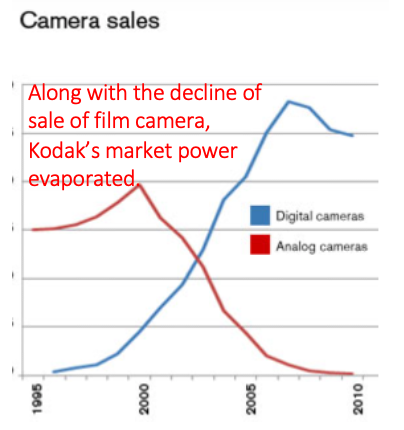Innovation waves unleash Creative Destruction effects, transforming businesses and driving economic growth. In the review of the history of 2000 years, the authors of “Why Nations Fail” found that lack of creative destruction is the root cause. Human beings’ inherent urge to recreate the world and get jobs done better has been unfolding innovation waves. As innovation waves offer better alternatives by destroying the demand for existing tools, skills, and jobs, creative destruction plays a key role. It has been the underlying cause of the success and failure of entrepreneurship and economic development.
In the 1940s, Prof. Schumpeter articulated the “creative destruction” theory, suggesting that economic progress occurs through the destruction of matured means by emerging alternatives. For example, economic growth was distilled due to the replacement of horse wagons by automobiles. However, such creative destruction has been an inherent phenomenon of human beings. For example, our ancestors replaced stone tools with iron counterparts millions of years ago. Similarly, they replaced inscribing on the wall through writing on papyrus 2500 BC. However, the emergence of alternatives in the pre-industrial age was not scalable. Hence, they could not unfold large Waves of Innovation.
In the industrial age, creative destruction waves are large, and they are getting larger—forming Long Waves of Innovation. For example, the implications of electric vehicles and renewable energy will have significant disruptive effects. Hence, business cycles operate under long waves of innovation– forming Kondratiev Waves. Consequentially, key clusters of industries are getting disrupted, having an outsized impact on the economy. Besides, innovation epicenters have been migrating across the boundaries of firms and nations due to innovation waves. Furthermore, winners have emerged with Monopolistic market power by leveraging innovation waves. Therefore, it’s imperative to understand the dynamics of innovation waves shaping prosperity.

Key takeaways of innovation waves
- Scalable technology core powering Reinvention forms innovation wave–market and economic prosperity expand due to evolution of inventions and innovations caused by scalable technology core.
- Due to the maturity of technology growth slowsdowns--growth out reinvention slows down due to the maturity of the technology core.
- New wave of growth shows up due to scalable emerging technology cores--slow growth is overcome by the emergence of new technology cores, powering the reinvention of matured products.
- Successive reinvention waves form long innovation waves–creation, growth, and maturity of reinvention waves lead to forming long innovation waves.
- Nikolai Kondratiev detected long waves in economic data–in a book in 1925, Nikolai Kondratiev reported the presence of supercycles, great surges, long waves, K-waves or the long economic cycle.
- Monopoly grows and gets destroyed due to long innovation waves–as the rise of reinvention waves takes place due to a Flow of Ideas in making products better and cheaper, market power through winning the race of ideas or innovation accumulates in each wave. However, the market power accumulated during the previous wave is often destroyed due to the creative destruction effect of the next wave.
Defining innovation waves
Innovation waves refer to macro-level transformational effects due to the reinvention of various products, unleashing disruptive effects on matured products, skills, jobs, and businesses. Most of the researchers have identified six innovation waves. The first one started to unfold in 1785, creating the first industrial revolution. Does it mean our ancestors did not pursue innovations in the pre-industrial age? History suggests that they were as creative as us in pursuing innovations.
However, their innovations were scalable due to their reliance on intuition, tinkering, and Craftsmanship. Hence, they could not form visible waves. However, the situation started to change because of UK-led Europe’s successes in scaling up knowledge generation and its usage for creating a flow of ideas. Besides, they succeeded in replacing craftsmanship with Engineering. Furthermore, adopting Market Economy principles fueled profit-making competition in leveraging ideas to advance products and processes. Consequentially, reinvention waves started to scale up and unfold as creative destruction—forming waves of innovation.
- First wave—From 1785 to 1845, due to the scaling of the steam engine, coal took over water, wind, and muscle power, making energy supply better, more reliable, and cheaper. Besides, mechanization created scale effects on cotton processing, yarn production, weaving, and finishing fabrics. Consequentially, the first wave of innovation unfolded, shaping the economy of the UK and the rest of Europe.
- Second Wave—Over 55 years, from 1845 to 1900, the steam engine powered the deployment of the rail network. Steam engines also scaled up steel production. The newly built rail network and steel supply combinedly affected countless industries, unleashing the second wave of innovation. Due to high scale advantage, monopolies started to form in rail and steel industries.
- Third Wave—Electricity-powered telephones, light bulbs, and motors started to unfold as major reinvention waves. Besides, internal combustion engines began to replace horses and steam engines. The advancement of chemicals fueled further momentum of transformation. Their combined effect created the third innovation wave, unleashing over 50 years from 1900 to 1950.
- Fourth Wave—The era between 1950 and 1990 is marked as the fourth wave. During this period, the reinvention of radio, television, cameras, telephones, and other consumer electronics products transformed many industries. Consequentially, tiny Startups like Sony grew into large enterprises, dislodging the dominance of mega-firms like RCA and Kodak. Besides, the continued growth of airplanes, automobiles, and petrochemicals added further momentum to the fourth wave. Like the second and third waves, the fourth wave created monopolies.
- Fifth Wave—The dawn of 1990 witnessed the rise of personal computers, software, and mobile phones. Subsequently, the Internet, notably the mobile internet, started to form a global information network. As a result, between 1990 and 2020, numerous industries, starting from typewriters, commerce, and media, have witnessed transformative effects. They have also created monopolies. However, instead of getting confined within national boundaries, firms like Apple, Microsoft, Facebook and Google became global monopolies.
- Sixth Wave—Besides driving prosperity, the last five innovation waves have created sustainability urgency. We can no longer cause innovation waves by worsening air pollution, greenhouse gas emissions, and resource depletion. On the other hand, the fourth and fifth innovation waves have formed the foundation of replacing humans’ cognitive role with machine capability. As a result, artificial intelligence, the Internet of Things, and clean energy technology will likely unleash the sixth wave of innovation during 2020-2050.
Schumpeter waves of innovation
As explained, Schumpeter’s waves of innovation refer to creative destruction due to the rise of reinvention waves of matured products as better alternatives. For example, the word processor is a creative destruction to the typewriter. Similarly, the mobile phone is a creative destruction to various products such as land phones, cameras, music players, and torch lights. In the 1940s, Prof. Schumpeter coined the term creative destruction to refer to the reinvention of products due to the change of technology core.

Long waves of innovation—forming Kondratiev waves
Irrespective of the greatness, every innovation wave reaches saturation. It happens due to the saturation of the underlying technology cores. Besides, each innovation wave begins in embryonic form, followed by a ramping-up state. Moreover, the saturation of previous waves overlaps with the embryonic beginning of the next wave. Hence, at the junction of the beginning of the next wave and the maturity of the previous one, additional contribution to economic growth is very low. However, during the ramping-up stage, economic growth accelerates. Hence, long-run economic growth shows cyclic behavior along with the unfolding of successive innovation waves.

In 1925, Soviet economist Nikolai Kondratiev first brought this observation to international attention through his book–The Major Economic Cycles. Subsequently, in 1939, Joseph Schumpeter suggested naming the cycles “Kondratiev waves” in his honor. Kondratiev waves form due to the saturation of the incumbent wave after the ramping-up period, followed by the next S-curve-like innovation wave.
Sixth innovation wave
The Fourth Industrial Revolution coincides with the sixth innovation wave. The sixth innovation wave refers to the reinvention of energy production and consumption through clean tech and transformational effect due to the advancement and adoption of robotics, IoTs, and AI. The sixth innovation wave is expected to reverse the trend affecting the sustainability issues caused by the previous five waves. Besides robotics, IoTs and AI will reinvent most products and processes by replacing human cognitive roles with machine intelligence.
Waves of technological innovation
Long-run innovation waves draw the attention of economists due to their consequential effects as supercycles, significant surges, long waves, K-waves, or the long economic cycle. However, it happens due to technological innovations caused by the reinvention of existing matured products and the invention of new ones. Hence, it would not shed much light on the underlying reason for the long economic cycle without understanding technology innovation dynamics. As technologies have been evolving in an episodic form, they have unleashed innovation waves, creating long or K-waves. Hence, due to technological innovation, innovation waves unfold, creating an economic or business cycle.
Market power

Market power refers to acquiring price-setting capability by winning innovation waves by offering higher quality at less cost. Innovation waves have been taking place due to the scalability of the underlying technology core, powering the subsequent reinvention waves. It appears that successive waves are far more scalable than previous waves. It happens due to the flow of material, labor, energy, emission, and time-saving ideas. Ideas are also creating positive externalities. Notably, due to the scope of replacing hardware with software and distance with connectivity, the scalability of ideas has been expanding. Hence, there has been a race to improve the quality and reduce the cost simultaneously through a flow of better ideas.
Consequentially, such a race has led to a surfacing winner who can offer higher quality at a lower cost. Thus, the winner attains market power. Due to the growing role of software and connectivity ideas, such market power during the fifth wave was far stronger than that of the previous waves. For this reason, Google, Facebook, Spotify, and Amazon did not take much time to become global monopolies.
Waves of change
As explained, innovation waves unfold creative destruction. They offer better alternatives by destroying the demand for existing matured products. However, they also create demand for new skills and jobs by eliminating older ones. The rise of startups by destroying the business of incumbents is also caused by them. Hence, innovation waves drive waves of change. Therefore, waves of change take place due to the creative destruction effect unleashed by innovation waves.
As explained, the episodic evolution of technologies creates innovation waves through the reinvention of matured products and processes. In addition to creating Kondratieff waves, innovation waves drive waves of change. They also migrate innovation epicenters across the boundaries of firms and nations. Hence, along with rising overall prosperity and creating economic cycles, firms and nations suffer from Wealth accumulation and annihilation. Such dynamics are vital for Capitalism to survive through the destruction of monopolies by innovation waves. Therefore, innovation waves demand serious management and governance attention. Particularly, aspiring nations to reach high-income status through idea economy must figure out how to leverage emerging waves, before the monopoly force surfaces.




